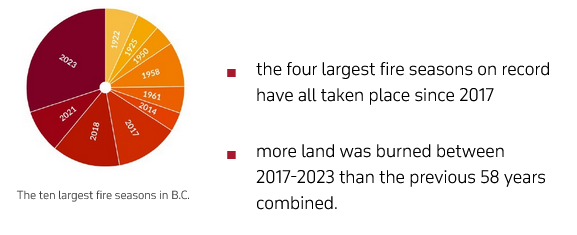The growing threat of wildfires in British Columbia and associated health risks are laid bare in two studies from experts at Simon Fraser University.
Recent years have seen a dramatic increase in both the number and intensity of wildfires, inflicting unprecedented ecological, social and economic damage, as well as posing severe risks to public health.
As authorities across the province brace themselves for another wildfire season, two SFU studies have looked at different aspects of what is an ever-increasing issue.
Sophie Wilkinson, assistant professor, Resource & Environmental Management, was part of a group of scientists that published a study in the Canadian Journal of Forest Research, in January.
The report looks at the drivers of wildfires and presents six strategies aimed at bringing about drastic changes in how B.C. approaches wildfire management and response.
"We cannot continue with the current approach to forest and wildfire management because we simply do not have a handle on it," says Wilkinson.
"We've had these recurrent wake-up calls in the last few years and not much has shifted."
The 2023 wildfire season was the largest on record in B.C. Fires burned some 2,840,545 hectares, an area greater than the size of Lake Erie.
While 2023 is held up to be an unprecedented year, it is actually part of a very worrying trend:

"Over the last century, our relationship with forests and wildfires has changed significantly, resulting in a highly flammable landscape," explains Wilkinson.
"Fire suppression, the exclusion of Indigenous fire stewardship practices, industrial land management, population growth and urban expansion - all have created a situation where there's too much fuel and a range of ignition sources.
"When you add climate change and warmer temperatures into the mix, then the conditions are conducive not only to more wildfires, but more extreme wildfires."
The study calls for "transformative change" to "amplify the pace and scale of change in response to recent wildfire extremes." The six strategies are:
- Diversify wildfire response strategies and restore the ecological and cultural role of fire in B.C.'s ecosystems.
- Invest in suppression capacity at local and national scales
- Mitigate risk and build resilience in communities
- Apply landscape fire management to drive a paradigm shift in forest management to increase ecological resilience to wildfire
- Transform wildfire governance to support collaborative and community-based solutions
- Strengthen expertise and capacity to uplift diverse ways of knowing, managing and coexisting with fire.
"None of these strategies will work alone. It needs to be transformative and collaborative," adds Wilkinson.
Wildfire smoke and extreme heat - a dual threat to health
A second SFU study, published by ACS ES&T Air in February, looks at how often wildfire smoke and extreme heat occur together in B.C. and the potential health implications for communities with increasing exposure.
With climate change comes more wildfire smoke and extreme heat. Taken in isolation, wildfire smoke and heat both pose threats to health.
Evidence suggests that wildfire smoke can lead to lung or heart-related health issues, while it can also negatively affect pregnancies.
Extreme heat can similarly increase the risk of lung, heart or brain complications, leading to illness or death. The 2021 heat dome killed more than 600 people in B.C. alone.
"We know the health risks of exposure to either wildfire smoke or extreme heat. But we live in a complex world where we are not exposed to only one hazard at a time," says Stephanie Cleland, assistant professor, Faculty of Health Sciences.
"Early studies suggest that simultaneous exposure to wildfire smoke and extreme heat amplifies the risks to health. Our motivation was to find out how often these hazards occur at the same time and which communities are most at risk.
"By answering these questions, we can take informed steps to mitigate the risks."
The study looked at temperature and air pollution data between 2010-2022 to calculate the number of days affected by both wildfire smoke and extreme heat.
Researchers also looked at whether the frequency and intensity of simultaneous exposure to these hazards has changed over time.
"We found there has been a significant increase in how many days per year communities are having to face these combined exposures," says Cleland, who co-authored the report.
"The major concern is not just that they're happening, it's that they're happening more often and with greater intensity."
The study found that all communities across B.C. experienced at least seven days of co-exposure to wildfire smoke and extreme heat between 2010-2022, with the worst affected areas experiencing upwards of 65 days.
To illustrate the increasing frequency of such events, communities faced simultaneous exposure to wildfire smoke and extreme heat only once per year on average, between 2010-2014. This jumps to 4.5 days per year between 2018-2022.
Communities in the northeastern and south-central regions of B.C. were more likely to feel the effects of frequent and intense exposure.
"The most affected communities tended to be rural and remote. That's a huge challenge when it comes to adaptation and mitigation as these communities are often further away from resources and essential services," says Cleland.
"We also found that these highly exposed rural communities often have a lower socioeconomic status and a higher proportion of susceptible populations, such as older adults."
The findings underscore the need to prepare B.C. communities for simultaneous exposure to wildfire smoke and extreme heat, rather than just focusing on one hazard or the other.
"Cities often open cooling centres during periods of extreme heat to provide access to air conditioning, but these centres don't always have air filtration," says Cleland.
"Similarly, cities often designate cleaner air spaces during periods of wildfire smoke to provide access to clean indoor air, but these spaces don't always have air conditioning.
"We need to work at a local level to design solutions that can help communities manage multiple hazards.
"Otherwise we will see more people suffering the health consequences of wildfire smoke and extreme heat, which will in-turn place a greater burden on a health system that is already under pressure."
-
The SFU BREATHE Project will be carrying out workshops this summer across B.C. The project is a community-based initiative that teaches community members how to build DIY air cleaners to improve their indoor air quality.












